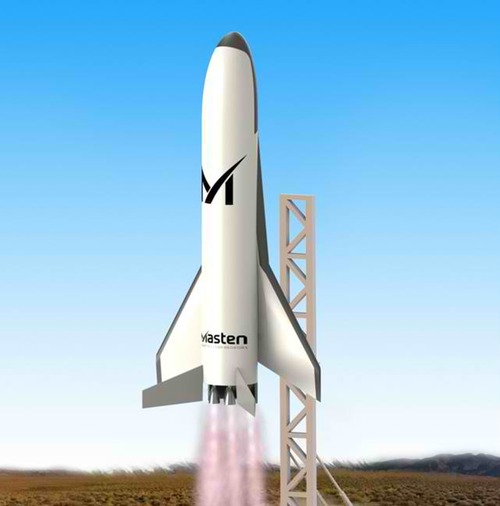
An illustration by Masten Space Systems of its Xephyr design that was funded by DARPA for Phase 1 of the XS-1 program. (credit: Masten Space Systems)
Masten Space Systems, one of three companies to receive awards from DARPA for the Experimental Spaceplane 1 (XS-1) program, has revealed the design it proposes to develop for the program. And that design has something unusual for a company best known for its vertical-takeoff-and-landing designs: wings.
The “Xephyr” vehicle does take off vertically, as shown in the illustration provided by the company. However, the design also has small wings, presumably to allow it to glide, either for landing or other phases of flight. Overall, the design bears similarities to the X-34, an experimental spaceplane developed by Orbital Sciences for NASA but cancelled before its first flight. The X-34 featured a single tail while Mastern’s Xephyr features two. The X-34 was also designed to be air-launched from an aircraft, while Xephyr will launch vertically and would eventually become an air-launch platform itself for an expendable upper stage. (It’s worth noting that XCOR Aerospace, which has experience with winged vehicles, is partnered with Masten on its XS-1 contract.)
“XS-1 comes at the right time for the industry and the right time for Masten,†said Masten CEO Sean Mahoney in a company press release issued Wednesday. “The tide is turning and space access is opening up. We’re thrilled to lead a team to tackle the hard problems DARPA has put in front of us.â€
Masten is one of three companies awarded Phase 1 contracts by DARPA for the XS-1 program. The other two are Boeing and Northrop Grumman.

I am in total support of winged spacecraft that return from space and land on a runway. All we need now is a working magnetic shield to keep the hot ionized gases from coming into direct contact with the craft’s skin and we will have the total package.
Congrats to Masten Space Systems on the award. It’s long been time for reusable first stages to have been in use.
Robert Clark